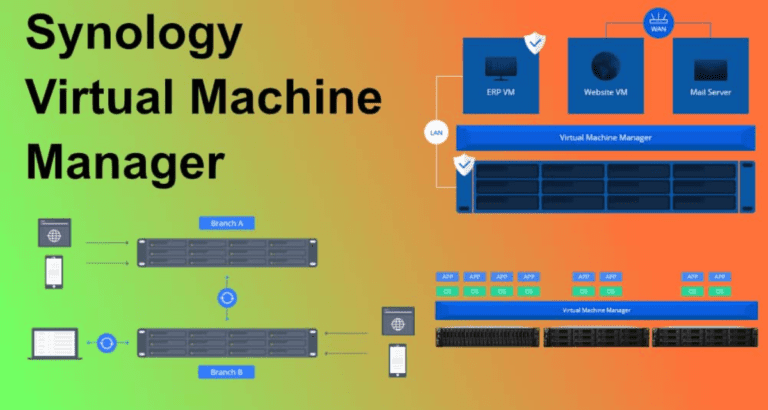Synology is winning over business customers by offering more than storage. Its combined hardware and software platform provides a unique solution. Besides backups, you’re able to run applications in virtual machines on a NAS. The Synology Virtual Machine Manager is available in DSM, allowing almost anyone to spin up a Linux or Windows VM.
During the introduction of Synology Virtual Machine Manager, Synology’s business ambitions were still small. In those days, the organization mainly focused on the lower end of the SMB market. Since then, the company has had time to develop the product. Its entire business strategy became more business-like. Today’s Synology wants to break into the business market and add enterprise customers to its portfolio. Synology is currently working hard on conquering the education and healthcare market.
The introduction of DSM 7.0 shows that Synology is taking the business customer more serious. DSM has gotten a redesign that is more appealing to business users. Synology wants organisations to get a better understanding of what DSM can offer. On how DSM and the system as a whole can cater to a company’s core business. Its broad portfolio of backup solutions and popular surveillance applications remain on top. However, Synology Virtual Machine Manager is probably the third most popular application.
What started with a simple VM
Synology Virtual Machine Manager started from the simple desire to run virtual machines on a Synology NAS. Spinning up a VM allowed users to run Windows applications on their NAS. The Synology Virtual Machine Manager quickly became popular among developers who run their development environment on a Synology NAS. The main advantage is that they can easily create backups and snapshots of their development progress. Another significant advantage is that the user can work on Windows, but run its dev environment on a Linux VM. Many web-based software projects often run on a Linux server in production. By running the dev environment in a Linux VM the developer gets a similar environment. By doing so, the software testing becomes more accurate. A Windows laptop or desktop PC doesn’t always match a Linux environment.
What started with simple virtualization quickly grew into one of the most popular Synology applications. Also, Synology Virtual Machine Manager has made Synology take a closer look at the specifications of its servers. To virtualize properly, you need a high-performance CPU that can handle virtualization. For that reason, we mostly see Intel Xeon processors in Synology’s modern business models. Somewhat cheaper models, Synology equips with a less powerful AMD processor. In any case, the more unknown ARM chips and Intel Celerons are a thing of the past.
From VMs to containers
With VM support in place, the move to containers is the most obvious next step. As such, Synology quickly added Docker support to DSM, allowing users to run containers on a Synology NAS. Ultimately, Synology wants to support virtualization in its broadest sense, ensuring it doesn’t only appeal to developers but also other IT professionals.
Synology ended up stuck in the test and development corner for a long time. Even though Synology offers solutions for production environments, customers are less likely to choose Synology for this purpose. To convince customers, Synology decided to take the bull by the horns. Synology now supports the storage platforms of all major virtualization platforms, allowing users to run any type of VM. Synology handles everything, from VMware vSphere and Microsoft Hyper-V to Citrix XenServer and OpenStack.
Building clusters
In addition, Synology made it possible to build VM clusters by releasing Synology Virtual Machine Manager Pro (VMM Pro), which features Live Migration and High Availability. With Synology VMM Pro, you can connect up to 7 nodes. Think of seven high-availability Synology RackStations, working together. The nodes form a cluster, allowing many more VM’s and snapshots to be created and managed. Live Migration is also supported, where a VM is moved from one node to another without the user noticing.
Furthermore, High Availability ensures that nodes can automatically switch from one node to another in a disaster scenario. It is particularly effective when placing nodes in different data centres. If one data centre suffers an outage, the application stays available through one of the other data centres. Lastly, customers can use Synology Active Backup for Business to make copies and synchronize data between different nodes for disaster recovery purposes.
VMM has matured in recent years. It’s no longer purely aimed at testers and developers. It can run in production just as well. According to Synology, many educational institutions and healthcare organizations in Europe are leveraging VMM. They were looking for an affordable on-premise solution that anyone can work with; Synology fits the bill.
Once it’s configured, it just keeps on working. Adding and spinning up a VM is something anyone can do. DSM’s accessibility and usability are excellent.
Virtual DSM
Large organizations with virtualization needs in multiple departments can build one large cluster consisting of several virtual DSM installations. All departments will run on the same cluster, but each department has its own Synology Virtual Machine Manager environment. Every department will only have access to its own VM’s.
Easy cluster building with DSM
Part of Synology’s power lies in DSM. With other platforms, it can take days to configure and connect nodes. Synology allows clustering with a few clicks from the DSM interface. Above all, its platform is simple and suitable for everyone — advanced and less technical users alike.
Availability
Synology Virtual Machine Manager is available for free on all Synology NAS servers with x86 processors. It works on Synology’s business models with Intel Xeon or AMD Ryzen chips. If your organization wants to build a cluster with 3 or 7 nodes, you must purchase a VMM Pro license. License fees range from a few hundred euros per year to about 1000 euros for three years. It depends on the number of nodes and the duration of the license agreement.



